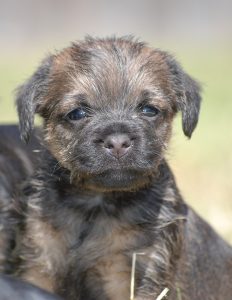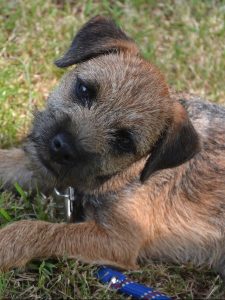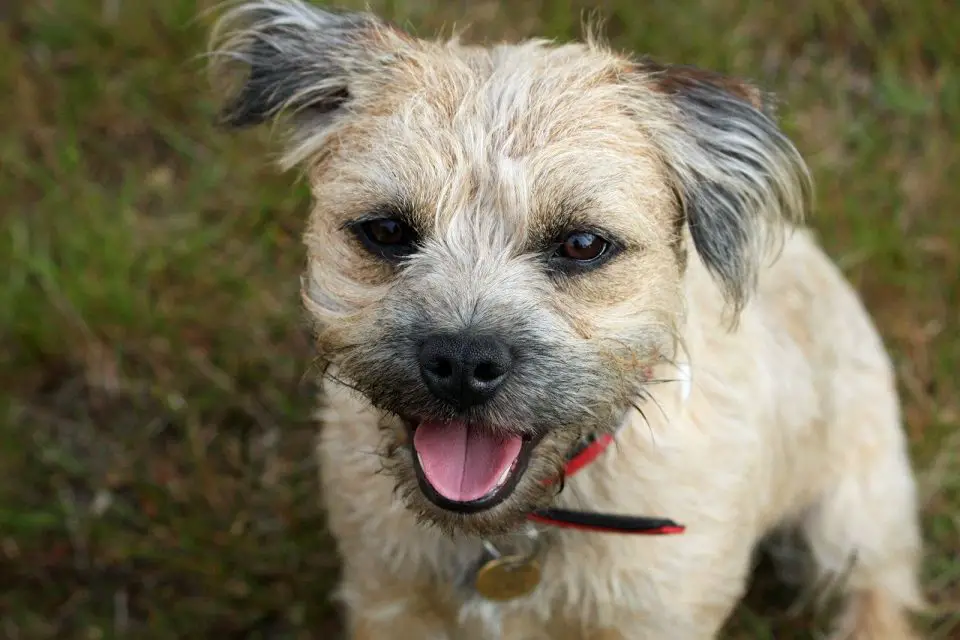A Little About Border Terriers
The Border Terrier is one of the smaller dogs under the classification of Terriers. Originally, they were bred to hunt foxes and vermin.
The ancestry of the Border Terrier includes the Dandie Dinmont Terrier and the Bedlington Terrier which were also bred to hunt.
The Kennel Club UK first recognized the breed in 1920. The American Kennel Club (AKC) recognized them in 1930.
The Border Terrier was bred with specific traits to hunt for foxes. You will see that they have long legs in order to keep up with horses. Thy are also small enough to allow them to crawl into fox burrows.
While foxhounds who also hunted foxes were too large to get into burrows, hence this became the job of the Border Terrier who would chase the foxes out for the hunters.
In 2006 the Border Terrier ranked 10th in the UK and 81st in the USA for the number of registrations. The breed became more popular and in 2008 it was number 8 in the UK Kennel Club.
While the breed was originally meant to hunt, these days they make great family pets.
Do Border Terriers Shed?
| Yes Border Terriers do shed, they are classed as minimal shedders and are not known to be high maintenance.
As with most breeds they will shed more at certain times of the year, namely spring and autumn. If your Border Terrier seems to shed more than normal, then you may want to have them checked out by a vet. |
While this breed does shed, they do not seem to drop much hair because it gets tangled in the undercoat and needs to be physically brushed out to remove it.
This is great news for people who do not enjoy large amounts of hair in the house, on furniture, and clothing.
Short History of Border Terriers
The original Border Terriers were called Coquetdales or Redesdale Terriers because of the area where they came from.
By the late 1800’s this was changed to Border Terriers. It is thought that name came from the Border Hunt in Northumberland.
In 1912 the first Kennel Club Border Terrier was registered, namely The Moss Trooper who was sired by Jacob Robson’s Chip. This dog was registered in the Kennel Club category of ‘Any other variety’ in 1913.
After being rejected by the Kennel Club in 1914 the Border Terrier then appeared again in 1920 where it was accepted.
What is a Border Terriers Coat Like?
The characteristics of the Border Terrier coat are hard and double. The double coat is made up of a short, dense, and soft undercoat, with a wiry, almost harsh topcoat.
The topcoat is weather and dirt resistant and lies close to the skin with no curls or waves. The recommended way to remove dead hair is to strip this coat twice a year.
The Border Terrier will shed hair minimally, in fact they are classed as light shedders.
The coat length is medium and grooming needs are moderate. You will find the coat in colors of wheaten, red, blue and tan, and grey and tan.
How Much do Border Terriers Shed?

This breed is classed as an average shedder which means that you will not be faced with piles of hair over the house.
The Border Terrier will shed more than normal if there are issues with diet or if they suffer from a skin infection, but generally this is not a breed that sheds a lot, unlike other double-coated breeds.
When do Border Terriers Shed the Most
A Border Terrier will shed more if they are unwell, have allergies or pest infestations. These will leave the skin red and raw, where they may lick and create a bald patch.
Bitches who are in heat, pregnant or lactating will also tend to shed a little more, although this will return to normal when the pups are weaned.
You can expect the Border Terrier to shed seasonally during spring and autumn and then minimally through the rest of the year.
How to Combat Border Terriers Shedding
Grooming the Border Terrier twice a year by hand will keep excessive shedding under control.
This process is called stripping and is simply done by pulling out the dead hair by hand. Some owners may prefer to use a stripping tool for this, but hand stripping is what breeders recommend.
Clipping the hair is another option to get rid of dead hair although this may not remove all the dead hair, it only shortens it.
Border Terriers who are clipped more than stripped tend to end up with faded color and sometimes more shedding. After stripping the topcoat takes about 8 weeks to grow back.
Naturally, a good brush will get rid of dead hair, if it is done regularly and gets all the way to the skin to remove hair.
Bathing will also help remove any dead hair. You should brush your pooch before you bath them and then again when they are dry to remove any remaining over hair.
Paying attention to quality of food and diet will help to ensure that your dog’s coat stays in good condition. Supplements like fatty acids may be added to further improve skin and fur condition.
Equipment Help to Combat Border Terriers Shedding
The scruffy, thick coat of the Border Terrier needs a good brush every week to keep it from tangling and becoming knotted.
A brush also helps you to keep an eye for any pest infestations which may happen if hair gets knotted.
Slicker brush
This is helpful to remove mats and tangles. There are de-tangling lotions available for it the hair gets very knotted. The brush will help to spread the lotions evenly over the hair.
Hand stripping tool
Although many owners prefer to strip by hand, there are stripping tools available which will also do the job. A complete stripping job will take you around three hours to complete.
Bathing and shampoo
Border Terriers do not need frequent baths because the water softens the wiry topcoat which is a natural repellant for dirt and debris.
If you do bath your pooch you should use a doggie shampoo which is formulated for dogs and not humans Do not be tempted to use human shampoo as it may irritate the skin.
Normally it a Border Terrier gets dirty, rubbing off with a damp towel will solve the issue.
Are Border Terriers Considered to be Hypoallergenic?
The Border Terrier is classed as hypoallergenic, even though in reality, there are no true hypoallergenic dogs.
Every breed sheds to some extent and none are truly hypoallergenic, although this breed comes close.
The second reason why the Border Terrier is classed as hypoallergenic is that they do not drool. They produce little dandruff, so they are excellent for families with allergies.
Allergy sufferers react to pet dander as well as urine and saliva. All dogs have these, so there is always a possibility of an allergic reaction. Some dogs slobber less and drop hair less, such as the Border Terrier.
Do Some Border Terriers Shed More Than Others?
 No, all Border Terriers shed about the same. They all have the same type of coat and will shed in the same way.
No, all Border Terriers shed about the same. They all have the same type of coat and will shed in the same way.
But there are health reasons for increased shedding in Border Terriers.
Parasites such as fleas and mites will cause these dogs to shed a little more, as will issues such as dermatitis and Ringworm.
Hormonal changes such as pregnancy and lactation will make a dog shed more as will an inadequate diet which does not contain enough fatty acids and essential nutrients.
Final Thoughts
For people who want a dog that is a great family pet, as well as a relatively non-shedding pooch, this dog checks all the boxes!
